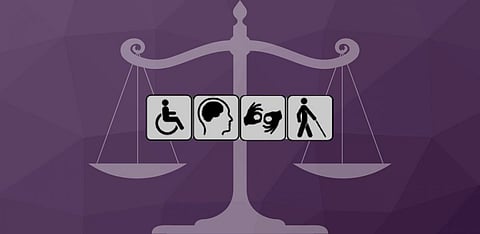

Three instances from the past week, two from the Supreme Court and one from the Delhi High Court, indicate improvements in access to justice for persons with disabilities.
—
THE Delhi High Court on Tuesday employed the services of a sign language interpreter while hearing a petition to make over-the-top (OTT) platforms disability friendly.
Justice Pratibha M. Singh of the high court is in the process of hearing a batch of petitions seeking directions for enforcement of various rights and accessibility requirements as prescribed under the Rights of Persons with Disabilities (PwD) Act, 2016.
Yesterday's proceeding saw two sign-language interpreters in the courtroom who translated the court proceedings for the hearing-impaired litigants present.
On a previous occasion, Justice Singh had asked the registrar general of the high court to engage the services of a sign language interpreter reasoning that the petitions raise the significant issue of accessibility of entertainment for visually and hearing impaired people.
In a related development, the Supreme Court on Friday allowed hearing-impaired advocate Sarah Sunny to argue with the help of a sign language interpreter.
A Bench led by Chief Justice of India Dr D.Y. Chandrachud was in the process of hearing a petition by Javed Abidi Foundation, a think tank that advocates for rights of disabled persons.
Meanwhile, in a national stakeholders consultation on child protection held on September 23, the services of sign-language interpreters were used.
The consultation event was organised by the Juvenile Justice and Child Welfare Committee of the Supreme Court in collaboration with UNICEF. The discussion focused on children in conflict with law.
Reportedly, the invites for the consultation and details about the programme were issued in Braille for the assistance of visually impaired persons.
One of petitions had sought directions to Yash Raj Films to include audio description, subtitles, and captioning in Hindi for the OTT release of the film Pathaan allowing persons with hearing and visual disabilities to access the film. The high court accepted the said plea.
In a later hearing in April, the high court ordered the Union government to collaborate with producers, broadcasters and disability rights organisations to prepare a report on making films and other content accessible to persons with disabilities.
In pursuance to the court's Order, consultations were conducted by the Ministry of Information and Broadcasting with the Film Federation of India and the South Indian Film Chamber of Commerce in June and July.
The ministry has assured the court that more consultations will be held.
In May this year, the Central Board of Film Certification (CBFC) issued an expression of interest for providing advanced technology solutions for accessibility in films for persons with disabilities.
The CBFC recognised that people with disabilities in India "are unable to enjoy recreational activities of media and entertainment due to physical challenges in vision, hearing or comprehension, resulting in their exclusion".
In the context of the petitions before the Delhi High Court and the use of sign-language interpreters on two instances by the Supreme Court last week, two provisions of the PwD Act hold relevance.
Section 12 (access to justice) of the Act mandates the government to ensure that persons with disabilities are able to exercise the right to access any court, tribunal, authority, commission or any other body having judicial or quasi-judicial or investigative powers without discrimination on the basis of disability.
Under this provision, the government is to make available all necessary facilities and equipment to facilitate recording of testimonies, arguments or opinions given by persons with disabilities in their preferred language and means of communication.
The government is to additionally ensure that all of its public documents are in an accessible format.
Section 42 (access to information and communication technology) of the Act mandates the government to take steps to ensure that all content available in audio, print and electronic media is in "accessible format".
It also mandates the government to ensure that persons with disabilities have access to electronic media by providing audio description, sign language interpretation and close captioning.